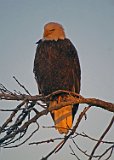
An Eagle At Sunrise
Eagles spent their nights perched in the cotton wood trees that line the river. Here is one being lit by the morning sunrise.

An Eagle At Sunrise
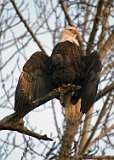
Eagle Drying Its Feathers
Eagles are good swimmers. Occasionally an eagle will "misjudge" and latch onto a fish too heavy or large for it to fly with. While neither the Chilkat River nor its Bald Eagle Preserve tributary the Tsirku River are wide, eagles are able to swim quite a distance, drag the fish up on shore and eat it. Late in the afternoon of my first day out on the Council Grounds I saw this eagle fly into a grove of trees and assume this position to dry its feathers.

Eagle Drying Its Feathers
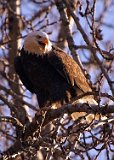
An Eagle Vocalizing
There was a constant din of eagles crying out. In some cases it would be mated pairs keeping in contact, in others it was clearly possession discussions, sometimes over fish, others over perches. Shortly after alighting in this tree this eagle sounded off. I could not determine who it was yelling at.

An Eagle Vocalizing
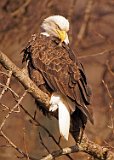
Grooming Time
While the river was not frozen, except for the middle of the day the weather was below freezing. It was typically in the low 20s as I walked from the motel to the foundation in the predawn morning, and it would have been even colder further north away from the Lynn Canal in the Eagle Preserve. While most of the eagles would simply perch quite still with fluffed feathers conserving body heat, others would take advantage of the midday "warmth" to groom themselves.

Grooming Time

A Juvenile Bald Eagle
The feathers of a juvenile eagle much duller than those of an adult eagle. Starting out dark grayish brown, as the eagle grows its markings change gradually from that to the striking high-contrast adult colors. From top to bottom: 1) Its head feathers start out a dark brown/black turning progressively lighter brown/gray reaching a dirty gray just before reaching the brilliant white of an adult. 2) Its eyes change from a dark brown, to a lighter brown, to a cream to its adult yellowish white.3) Its beak and goes from a dark black to a gray/black mixture to a yellow/gray mixture to a bright yellow. 4) Its lower breast feathers start out dark brown becoming mottled brown/white and then returning to a very dark brown. 5) Its tail is initially black with gray near the vane changing to a mixed gray/black to the final pure white. This process takes about five years. This is a picture of a juvenile bald eagle. I would estimate it's age at between 9 and18 months. Note the dark head, brown eyes, yellow/gray beak and mottled breast& tail. As a side note, a juvenile bald eagle is actually larger than a fully grown adult. This is due to the plumage of a juvenile being longer and thicker than that of an adult. The adult is more streamlined with fewer and shorter feathers which contribute to its graceful flight. The longer feathers make the juvenile a bit clumsy in flight..

A Juvenile Bald Eagle
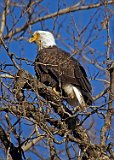
Eagle With Deformed Beak
Deformed beaks are a common reason for rehabilitated eagles to be declared non-releasable. It is felt that the deformed beak makes it difficult to impossible for the eagle to eat. However as this picture demonstrates, there are some eagles with deformed beaks who are able to feed themselves. This eagle is clearly well fed and with mature adult feathers, he is at least five years old.

Eagle With Deformed Beak
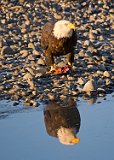
Mirror, Mirror on the Water...
I walked half a mile down the highway. At this point a small channel of the river branched off from the main channels and ran along the highway. The water was calm and there was minimal ice in this channel resulting in a mirror like finish. There I saw this eagle enjoying a piece of salmon. Over a 5 minute period I took a number of pictures of it eating. This is my favorite

Mirror, Mirror on the Water...
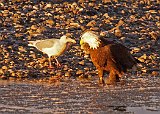
Don't Even Think About It
This picture is part of a sequence that I took one morning. Not obvious in this picture is the chunk of salmon that the eagle is standing on. Throughout the sequence the gull kept inching closer and closer to the eagle (and the fish). Finally the eagle took the fish, put it in the water, stood on it and turned to face the gull. After a short faceoff, the gull saw the wisdom of leaving the eagle alone and departed the area.

Don't Even Think About It
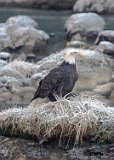
Eagle On Rock
Despite all the propaganda about eagles and the Chilkat Eagle Preserve, someone forgot to tell the eagles. This one was sitting on a rock in the Chilkoot River which is on the other side of the mountain from the Chilkat. The white on the grass is hoar frost.

Eagle On Rock

Eagle At A Spruce Tree Top
On the Chilkoot River side Sitka spruce trees dominated the landscape. I took a series showing an eagle flying up to and landing at the top of a large spruce. This is the final picture of that sequence where he is announcing his presence to the world.
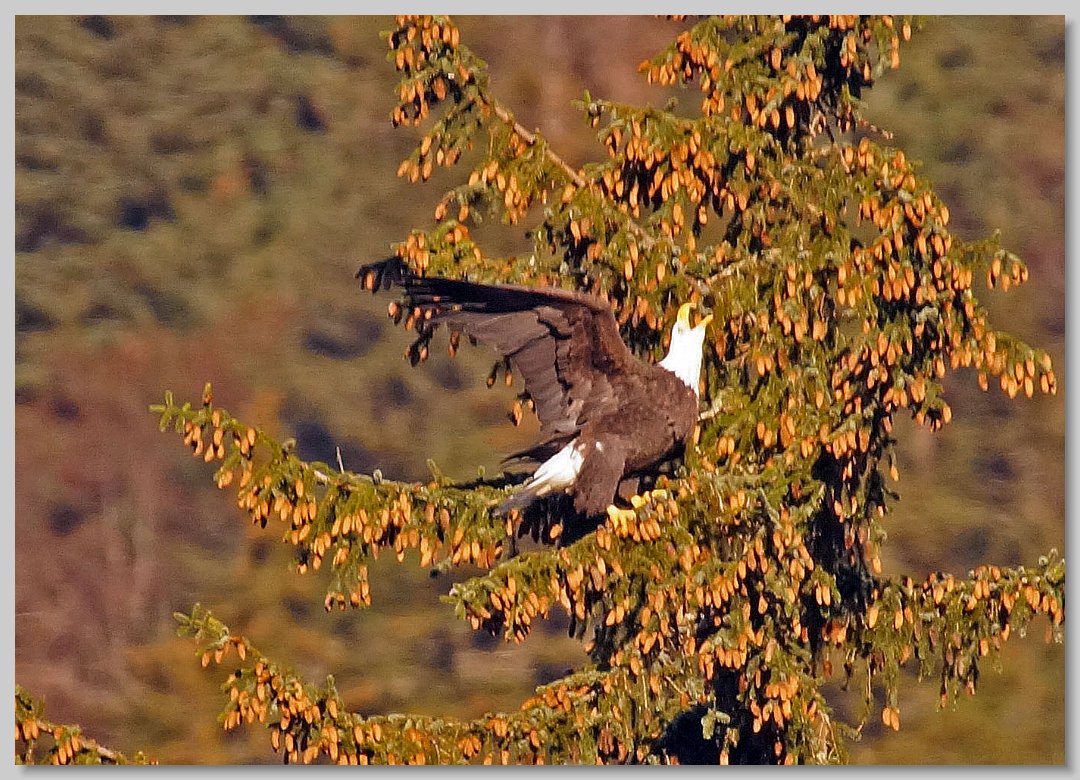
Eagle At A Spruce Tree Top
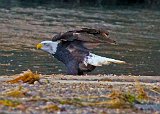
Eagle Preparing To Leave
On the way back to the Chilkat from our excursion to the Chilkoot, Bill took us into an area near milepost 16. Here the road was further away from the river, so we parked and walked towards the river. Approaching a channel we saw several eagles on the ground. I walked slowly to this eagle, taking pictures. For most of the way a rise blocked my view of its lower body. When I almost reached the top of the rise it decided I was just too close, and departed the scene. This is the last picture I took of that sequence. After I retreated, it came back and continued whatever it was doing there, presumably eating.

Eagle Preparing To Leave
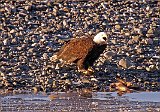
A Radio Tagged Eagle
Researchers will tag eagles to study their movements by mounting radio transmitters on their backs. This is a picture of one such eagle. The transmitter is mounted between its wings. The antenna can be seen - it is the wire coming out of the eagle's back. It is just a straight wire - what appears to be a bulb on the end of the wire is merely a rock in the background. One of the other photographers in the photography workshop captured a picture of a flying eagle (this one?) with a transmitter antenna clearly visible.

A Radio Tagged Eagle
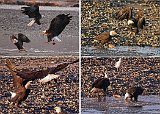
Clashing Eagles
In reality eagles are not the noble bird that Americans like to think they are. As Ben Franklin once observed in a letter to his daughter "He is a Bird of bad moral Character. He does not get his Living honestly." Based on my observations during the festival, an eagles first choice for obtaining food is to steal it from others. This collage shows typical eagle clashes over food. The bottom right shows a typical post clash announcement "This is MY fish now"

Clashing Eagles
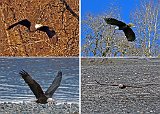
Flying Eagles Collage
The hardest pictures to take are those of birds in flight. Between tracking, having a fast enough exposure to prevent blurring, and focusing, the majority of the pictures of birds in flight are problematical at best. These are the best four eagles in flight pictures that I took during the festival.

Flying Eagles Collage
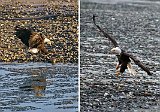
Landing Eagles Collage
Taking landing eagle pictures have the same problems as flying eagles - plus there is a time limit. Fortunately cameras have rapid exposure modes so one can keep the best and delete the rest. I particularly like the one on the left where its target is obvious, and give or take the ice, it is reflected in the water. Unfortunately its talons were opening and my shutter speed was not fast enough, so they are blurred.

Landing Eagles Collage

